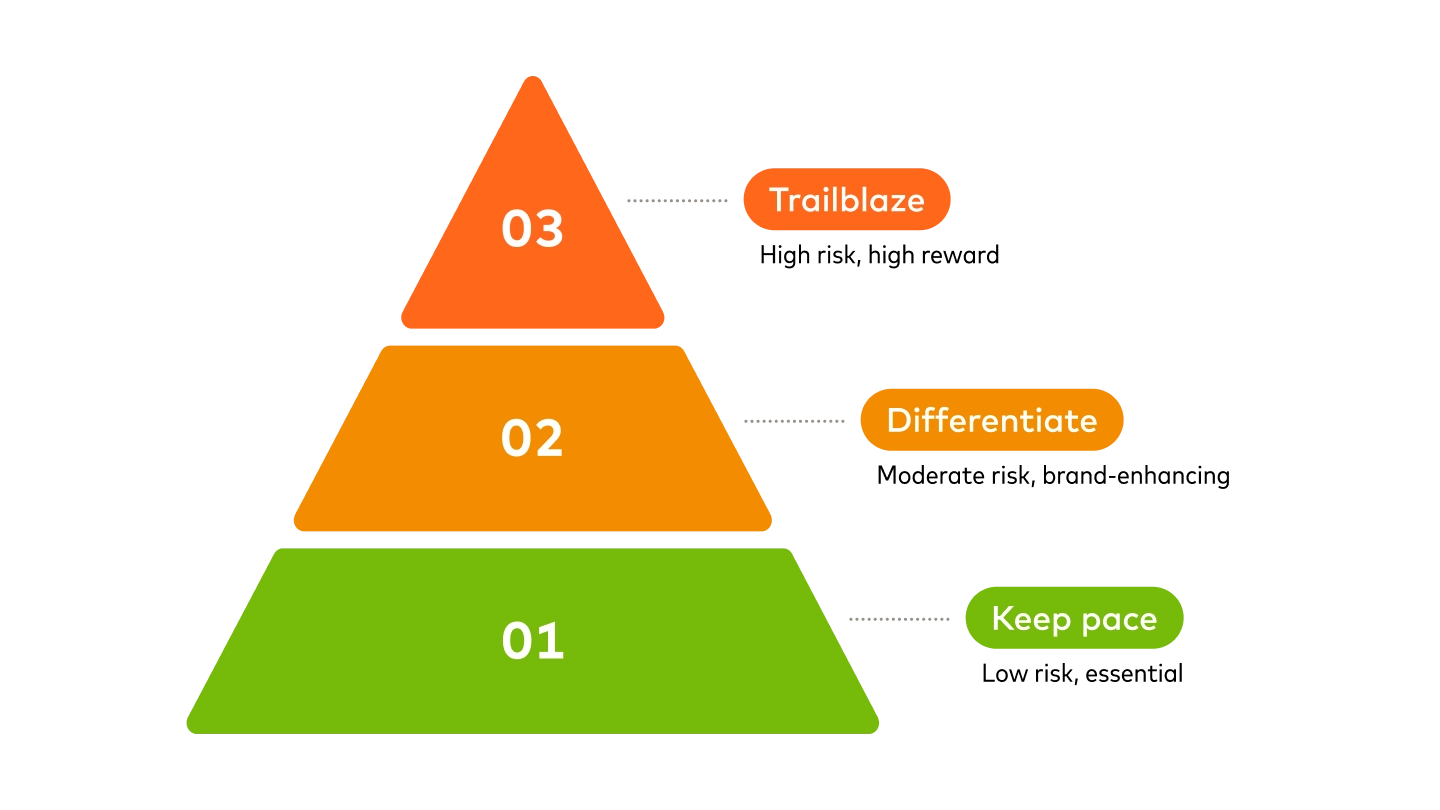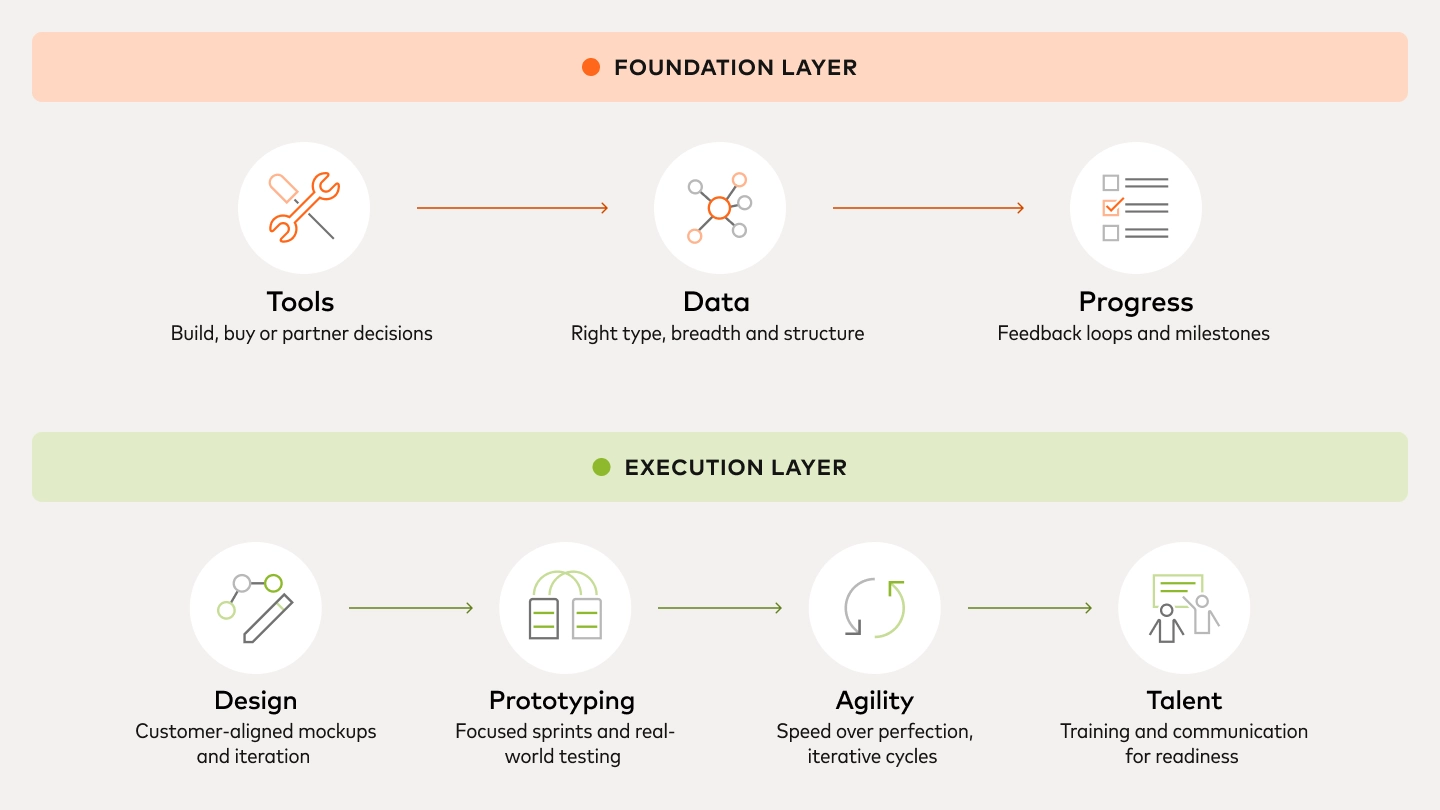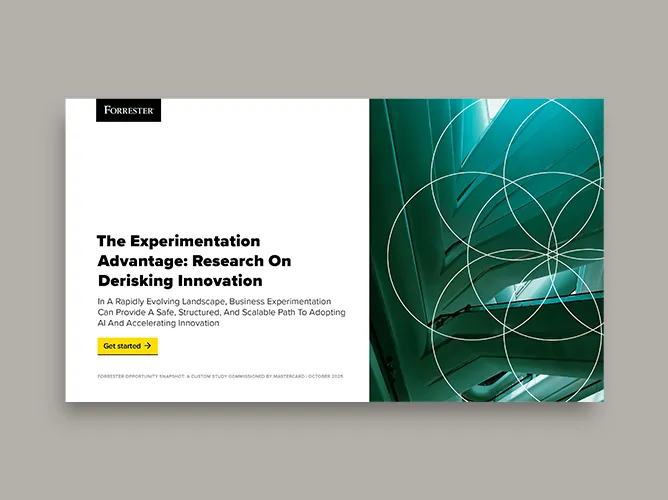Originally published by Tearsheet on 9/9/25. Last updated 10/6/25.
- Artificial intelligence (AI) is everywhere — but it’s not a shortcut to success. As organizations race to deploy AI across operations, it’s clear that ambition alone won’t deliver measurable impact.
- Organizations must establish an AI innovation framework that harmonizes risk management and innovation through aligned objectives, measurements and execution strategies.
AI’s potential is undeniable — but for many organizations, the path from ambition to impact is riddled with risk. Forty-seven percent of executives say AI has not met their expectations.
To change that, firms need a clear AI innovation framework that balances risk and new ideas from day one by aligning goals, measurement and execution.
In this article, we break down key steps of the innovation process from the De-risking innovation in the age of accelerated AI guide so that organizations can turn bold moves into smart bets.
Set AI innovation goals that match your risk appetite
Before launching any AI initiative, organizations must first calibrate their ambition to their AI risk appetite. Mastercard’s framework outlines three strategic orientations – to keep pace, differentiate or trailblaze – each with a distinct risk profile and expected returns:
- Keep pace: These initiatives focus on matching competitor performance and capabilities. They carry the lowest risk and typically yield incremental gains in efficiency and productivity. The goal is operational parity — ensuring the organization doesn’t fall behind.
- Differentiate: Projects in this category aim to outperform peers by enhancing the customer experience, streamlining workflows or optimizing pricing. They involve moderate risk and offer measurable improvements in reach, profitability and brand distinction.
- Trailblaze: These are new opportunities with greater risk that are designed to reshape market dynamics. They often involve novel business models or technologies — such as embedded finance or AI-driven product design — and require a greater tolerance for uncertainty but can yield outsized returns.
AI innovation risk reward tradeoff

By identifying where AI innovation sits on this spectrum, organizations can better align their strategy, resources and expectations.
Focus on measuring the impact of AI
Half of organizations lack AI performance indicators that track the business outcomes of their AI innovation efforts. Without clear AI success measurement, they’re flying blind — unable to assess progress, pivot when needed or prove value.
Mastercard’s framework offers a practical way to measure the impact of AI by evaluating whether initiatives make the organization smarter, more personal and more secure:
- Smarter: AI's data analysis capabilities enable organizations to examine internal and market trends, boosting operational efficiency. Organizations should assess whether AI initiatives improve understanding of operations, customers and market dynamics effectively.
- More personal: AI can also help retailers and FIs build more personalization into their digital footprint and customer experience (CX). Organizations should monitor what improvement AI initiatives introduce in tailoring experiences to customers’ needs.
- More secure: AI and machine learning are becoming essential tools for businesses seeking to detect and eliminate fraud. Businesses should pay attention to how their AI initiatives are improving their security posture by measuring increases in trust, safety and resilience.
Empower AI deployment
Even with clear goals and strong measurement, initiatives can falter without a deliberate AI deployment strategy. Mastercard’s AI innovation framework breaks implementation into two distinct phases: a foundation layer and an execution layer:
Foundation layer
This phase focuses on establishing the infrastructure needed to support successful AI initiatives.
- Tools: Organizations must decide whether to build, buy or partner. The right choice balances internal capabilities with speed and cost.
- Data: AI is only as good as the data it runs on. Organizations should ensure they have the right type, breadth and structure of data to support their goals.
- Progress: Integrating feedback loops and trackable milestones helps teams demonstrate early value and stay aligned with business outcomes.
Execution layer
This phase moves ideas from concept to reality, emphasizing agility and alignment.
- Design: Strong infrastructure only goes so far if the experience doesn’t reflect what customers need. It helps to align mockups early and create space for idea generation and iteration before development begins.
- Prototyping: Prototyping tends to work best when broken into focused sprints with clear goals. Testing in real-world scenarios can surface valuable insights early on.
- Agility: To scale, businesses need agile development cycles, with focused sprints and clear goals. These cycles prioritize speed over perfection and iterate based on real feedback.
- Talent: Even the best tools need the right people and support to succeed. Building readiness through communication and role-based training can help teams feel confident and engaged.
Mastercard’s AI innovation framework

As Bola Asiru, Global Vice President of Digital Consulting Products at Mastercard, puts it:
“Rapid prototyping and agile development aren’t just buzzwords — they’re how we de-risk innovation. The faster we pilot and pivot, the faster we deliver what actually works.”
Turn AI innovation ambition into strategic action
AI’s potential is immense — but ambition alone won’t be enough. To deliver real impact, organizations must align their AI innovation strategy with risk appetite, embed meaningful AI impact measurement and empower teams to deploy with agility and intent.
Mastercard’s framework helps organizations de-risk AI innovation and turn bold ideas into smart bets — from planning and prototyping to execution and performance tracking.











